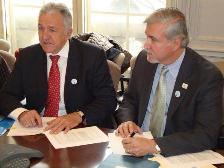The Plumbing Efficiency Research Coalition (PERC) is pleased to announce the publication of the Phase 2.1 supplemental report on the drainline transport of solid waste in building drains. The Phase 2.1 report details the findings from additional work the Coalition was able to conduct using remaining funds carried over from the PERC 2.0 research study. The Drainline Transport of Solid Waste in Buildings – Phase 2.0 was originally released in September of 2015. The PERC 2.1 findings appear as a new appendix to the PERC 2.0 report, and the combined reports are available for download free of charge on the PERC website: https://plumbingefficiencyresearchcoalition.org.
PERC was formed in 2009 through a Memorandum of Understanding (MOU) to develop research projects that support the development of water efficiency and sustainable plumbing products, systems, and practices. PERC identified drainline transport as its first research project. The six members of the coalition are represented by: Mary Ann Dickinson, Alliance for Water Efficiency (AWE); Billy Smith, American Society of Plumbing Engineers (ASPE); Peter DeMarco, International Association of Plumbing and Mechanical Officials (IAPMO); Fred Grable, International Code Council (ICC); Michael Copp, Plumbing-Heating-Cooling Contractors National Association (PHCC); and Barbara C. Higgens, Plumbing Manufacturers International (PMI).
The Phase 2.1 supplemental report focuses on two previously unaddressed areas of study — the implications surrounding dual flush toilet discharge patterns, comparing results to single volume flush toilets of comparable flush volume, and on the impact of drainline slope deviations on the transport of solid waste.
“The PERC Phase 2.1 provides new and useful information for the plumbing trades, engineers, designers, code officials, water efficiency experts, and manufacturers,” said IAPMO’s DeMarco, who acted as technical director for all of the PERC drainline transport studies.
For More Information Contact:
Barbara C. Higgens – bhiggens@safeplumbing.org
Billy Smith – bsmith@aspe.org
Charles R. White – white@naphcc.org
Fred Grable – fgrable@iccsafe.org
Mary Ann Dickinson – maryann@a4we.org
Pete DeMarco – pete.demarco@iapmo.org




